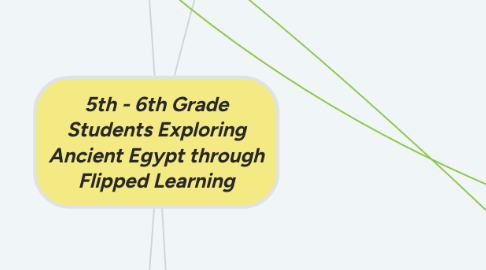
1. Teacher's Role
1.1. Including
1.1.1. Evaluator
1.1.1.1. assessing
1.1.1.1.1. Student understanding of lesson content
1.1.1.1.2. Student mastering of learning objectives
1.1.1.1.3. Students' ability to work in groups with other students
1.1.1.1.4. Students ability to utilize technology tools
1.1.1.1.5. Effectiveness of unit plan, unit activities, and lesson content
1.1.2. Course Builder
1.1.2.1. developing
1.1.2.1.1. Online course structure where flipped materials will reside
1.1.2.1.2. Short topical videos on unit content
1.1.2.1.3. Instructional plan for unit
1.1.3. Technology Support
1.1.3.1. providing
1.1.3.1.1. Documentation on how to use VoiceThread, Google Classroom, Kahoot, and Googlio
1.1.3.1.2. Support for technical questions regarding VoiceThread, Google Classroom, Kahoot, and Googlio
1.1.3.1.3. Tips and tricks for making the most of VoiceThread, Google Classroom, Kahoot, and Googlio
1.1.3.1.4. Examples of past student work to provide students with examples of expectations
1.1.4. Researcher
1.1.4.1. curating
1.1.4.1.1. Media resources on Ancient Egypt
1.1.4.1.2. Print resources on Ancient Egypt
1.1.4.1.3. Digital resources on Ancient Egypt
1.1.4.2. sharing
1.1.4.2.1. Sites where students can locate additional resources for own projects
1.1.4.2.2. Best practices in locating good resources on the internet
1.1.5. Facilitator
1.1.5.1. leading
1.1.5.1.1. Formative feedback sessions where students' understanding of material is gauged
1.1.5.2. asking
1.1.5.2.1. Guiding questions to lead students to understandings
1.1.5.2.2. Reflective questions to promote student reflection on learning
2. Learning Assessment
2.1. before unit
2.1.1. Video Reflection
2.1.1.1. gauges
2.1.1.1.1. Providing an opportunity for continuing to engage with major ideas from the lessons outside of classroom
2.1.1.2. measured via
2.1.1.2.1. VoiceThread
2.1.1.3. measured by
2.1.1.3.1. Rubric
2.1.2. Online Discussion Forum
2.1.2.1. gauges
2.1.2.1.1. Posting students' questions and discuss with peers
2.1.2.2. measured via
2.1.2.2.1. Canvas discussion board
2.1.2.3. measured by
2.1.2.3.1. Rubric
2.2. during unit
2.2.1. online quiz
2.2.1.1. gauges
2.2.1.1.1. The students' learning of the content material
2.2.1.2. measured via
2.2.1.2.1. Kahoot, Plickers
2.2.1.3. evaluating
2.2.1.3.1. To recall the content or materials
2.2.1.3.2. To provide rationale or reasoning for the responses
2.2.1.3.3. To ensure students' understanding of the threshold concepts covered online
2.3. after unit
2.3.1. e-portfolio
2.3.1.1. measures
2.3.1.1.1. Students' synthesis of unit content and ability to reflect on learning.
2.3.1.2. measured via
2.3.1.2.1. Googlio
2.3.1.3. measured by
2.3.1.3.1. Rubric
3. Learning Goals
3.1. Students will
3.1.1. Identify content specific vocabulary words and understand the meanings
3.1.1.1. such as
3.1.1.1.1. pharaoh
3.1.1.1.2. pyramid
3.1.1.1.3. mummy
3.1.1.1.4. embalm
3.1.1.1.5. canopic jars
3.1.1.1.6. papyrus
3.1.1.1.7. hieroglyphics
3.1.2. Identify the importance of the Nile River to the ancient Egyptians
3.1.2.1. significant because
3.1.2.1.1. Home of earliest civilization
3.1.2.1.2. Provides fertile topsoil
3.1.2.1.3. Economic stability
3.1.3. Understand and identify how ancient Egypt was protected by natural borders
3.1.3.1. from invasion
3.1.3.1.1. Sahara Desert
3.1.3.1.2. Cataracts or large waterfalls
3.1.3.1.3. Mediterranean Sea
3.1.3.1.4. Large boulders
3.1.3.2. could invade
3.1.3.2.1. By crossing Isthmus of Suez
3.1.4. Understand and identify parts of the ancient Egyptian writing system
3.1.4.1. using
3.1.4.1.1. Papyrus
3.1.4.1.2. Hieroglyphics
3.1.4.1.3. Scribes
3.1.5. Identify famous ancient Egyptian pharaohs
3.1.5.1. such as
3.1.5.1.1. Menes
3.1.5.1.2. Thutmose II
3.1.5.1.3. Akhenaton
3.1.5.1.4. Tutankhamen (King Tut)
3.1.5.1.5. Rames II
3.1.6. Understand the significance of the afterlife of an ancient Egyptian pharaoh
3.1.6.1. buried with
3.1.6.1.1. Food
3.1.6.1.2. Objects to bring comfort on journey underground to afterlife
3.1.6.2. mummification
3.1.6.2.1. Remove brain
3.1.6.2.2. Lungs, liver, stomach, and intestines were preserved in canopic jars
3.1.6.2.3. Leave in the heart
3.1.6.2.4. Drain bodily fluids
3.1.6.2.5. Wrap in layers of linen
3.1.6.2.6. Put body in coffin or sarcophagi
3.1.6.2.7. Placement of breathing stick
3.1.6.3. intact body
3.1.6.3.1. Buried in pyramids
3.2. including
3.2.1. Integrate and use technological resources to enhance learning
3.2.1.1. such as
3.2.1.1.1. Internet
3.2.1.1.2. Smartboard
3.2.1.1.3. Computers
3.2.1.1.4. Virtual Reality Headsets
3.2.1.1.5. Smarphones
4. Learning Activities
4.1. In class
4.1.1. Recalling information through
4.1.1.1. In class formative assessments
4.1.1.1.1. using
4.1.1.2. Asynchronous group discussions
4.1.1.2.1. using
4.1.2. Creating
4.1.2.1. Maps documenting important places in Ancient Egypt
4.1.2.1.1. using
4.1.3. Synthesizing knowledge through
4.1.3.1. Creation of portfolio of learning
4.1.3.1.1. using
4.1.3.2. Creation of presentation on topic related to Ancient Egypt
4.1.3.2.1. using
4.2. Outside of class
4.2.1. Exploring content through
4.2.1.1. Virtual simulations of locations in Egypt
4.2.1.2. Videos
4.2.1.3. Webquests
4.2.1.4. Resource sites
4.2.1.5. Digital maps

